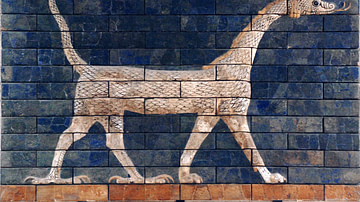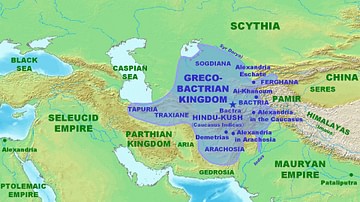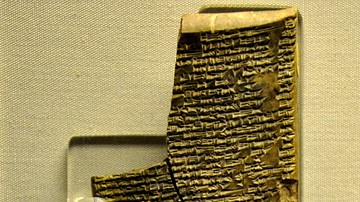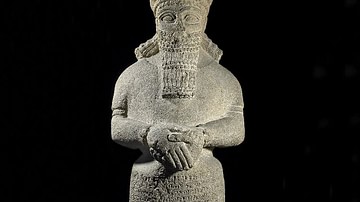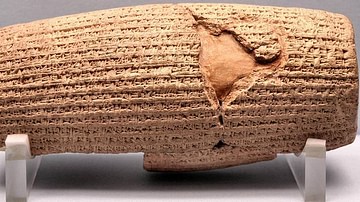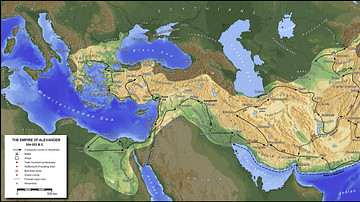Warning: See the definitions of Greco-Bactrian and Indo-Greek Kingdoms before reading this article, otherwise the following lines could give you serious headaches!
A lack of information is a common problem for historians of the Greco-Bactrian and Indo-Greek kingdoms, due to the almost-inexistence of written accounts about them. The fact that the modern political problems in the area allow looters to spread whatever remains in all directions makes things worse, as it is removing the possibility of scientific studies. Most of what we know about those kings is through numismatics. Although Greek and Roman literature speaks of about 6 Greco-Bactrian kings, coins number more than 32 kings! Knowing this, and the fact that a lot of coins are still circulating around the world without scientific study, the hypotheses and reviews of chronology for those kings are numerous, and almost every year brings new hypotheses to this really complex problem.
Some unorthodox hypotheses are found in the book of Widemann from 2009 (see references), and even if a priori they seem a bit far-fetched, some parallels with other Hellenistic kingdoms and with some Indian problems make them surprisingly plausible. The principal hypotheses are detailed in the following lines:
(1)
The principal problem that occurs in the study of Greco-Bactrian and Indo-Greek kingdoms is the number of their kings. More than 32 kings in not really more than 250 years, is hard to imagine. In his book, Widemann takes the idea, which is also found implicitly in Mitchiner, that some Bactrian kings could have been co-opted. The following reasons are possible:
There is proof of fighting between Greco-Bactrian kings soon after they conquered Indian territories in the Punjab. After this we have several kings who issued only monolingual coins (Greek), and others who issued almost only bilingual ones. This shows a geographical frontline between those kingdoms somewhere in the Hindukush, some ruling over the Bactrian territories and the others over the Indian ones. A deep study of the coin legends shows that it seems Greco-Bactrian kings, at least at some point, used titles a different way than other Hellenistic kingdoms. In the memorial coinage of Agathokles (where on the obverse the king is commemorated and on the reverse is Agathokles himself), posthumous titles are added to kings. One of them, Theos (meaning "the God") is added to Euthydemos I, who is called like this in his coins, and to Diodotos I, whom we know that he let his son Diodotos II take part of kingship during his reign.
This, added to a somewhat intriguing title of a later queen, Agathokleia "Theotropos", which can be put in parallel with the usual "Epitropos" title meaning "regent", lets Widemann think about a designation of superiority by the kings who take the title Theos. They were always the ones who made monolingual coins and ruled in Bactria, meanwhile the others, called Sôter ("Saviour") or Dikaios ("The Just"), are always issuing bilingual coins. Note that, since Eucratides' usurpation c. 170 BC, this system no longer applies.

(2)
We also have the problem of the Saka invasions in the Ganges area. Bopearachchi talks about a Saka invasion c. 70 BC which led to the rule of the mighty Maues at Taxila. Nevertheless, there is no proof of such an invasion.
Maues is a special case: First he is the only Saka ruler to represent himself by a bust on his coin, the others showing themselves on a horse, like mounted warriors.
Second, there is a rare coinage of him with a certain queen Machènè (she is on the observe with the Greek legend, and he is on the reverse with the kharosthi legend). Machènè seems to be a Greek name, and the character which is at the obverse is usually the most important. If they were married, or if she was regent, they would be on the same side of the coin, like all others did, even Indo-Greek ones (see Calliope/Hermaios, or Agathokleia/Strato for example). So there is probably something different here.
Widemann's thesis is that Maues was the chief of the Sakas settled in the Indo-Greek kingdom. This is highly possible: We have proof that Bactrian kings used Sakas to contain other invaders; many of them probably became somewhat Hellenized and went south to Punjab with their Greek rulers when they abandoned Bactria to the Yuezhei. The kind of representation that is found on Maues' coins supports this argument. Maybe Maues took an important place in a moment of crisis, such as being a vice-regent. We have a certain Telephos, an Indo-Greek king by his name at least, who called himself "son of Maues". Maybe he was the son of Machènè, and as queen she looked for the protection of the Sakas and so found Maues in a time of weakness? We must not forget that in Macedonia, Antigonos Doson, being the vice-regent for Philip, appears in an inscription with the title of king, although Philip gave him no title.
We know far too little to say what is right or wrong, but what is certain is that Maues was not a "Saka invader" from the North of the Hindukush. His coins show him like an Hellenized Saka, probably one of those settled in Indo-Greek Patalene or Surastene.
(3)
Following Bopearachchi, there was an almost-consensus that the last Indo-Greek kingdom survived in the Eastern Punjab until c. 10 AD, under the rule of Strato II or III. Nevertheless, taking one hypothesis of Bopearachchi in another way, there are some indications that could show us that there still existed one Indo-Greek kingdom around Alexandria Kapisa (Alexandria of the "Caucasus") until c. 15/20 AD.
The problem is related of the "Hermaios" coinage. Many coins bearing this name have been discovered, but the chronological field of those coins is really too large for only one king. In ancient times, kings never put a number after their name when they were not the first to take the name. For example, Ptolemaios XI issued "Ptolemaiou Basileôs", without any number. Even knowing this, Bopearachchi chose to put some of the "Hermaios coins" in a "barbarous imitations" section, due to their poor style and their belonging to the Hindukush area in the very late 1st century BC, because that is the only really plausible solution that works with his theory on the Saka invasion c. 70 BC.
Nevertheless, the Sakas who settled into independent kingdoms in India in the 1st century BC seemed to have always made coins with their own representations and names. Even the Sakas of Seistan, West of the Hindukush, had at this time their own coinage, so why imitate the series of an Indo-Greek king? In the same way, there is coinage of Hermaios (at the obverse in Greek legend), but with a reverse of the koushan Kujula Kadphises (in Kharosthi).
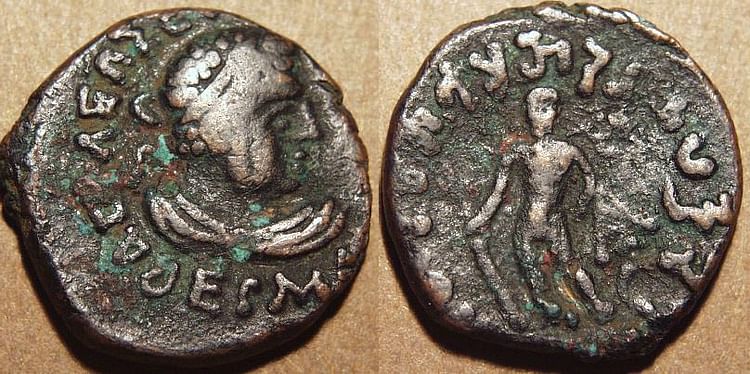
So here are three theses that could, if proven correct, change many of our views on Bactrian history and even also on Indian and Indo-Saka history. The co-opted system of rulership would make those Indo-Greek kingdoms even more exceptional and interesting to study, showing an example of how to deal with the problem of ruling two very different and separate areas in ancient times.

